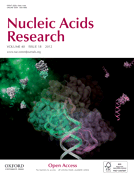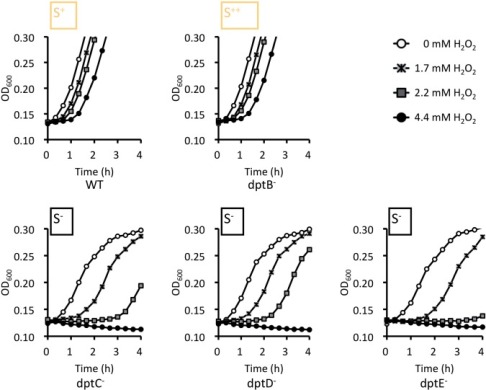NAR: Phosphorothioate DNA, an antioxidant in bacteria
 Nucleic Acids Res. 2012 Oct;40(18):9115-24. doi: 10.1093/nar/gks650.
Nucleic Acids Res. 2012 Oct;40(18):9115-24. doi: 10.1093/nar/gks650.
Phosphorothioate DNA as an antioxidant in bacteria.
Xie X, Liang J, Pu T, Xu F, Yao F, Yang Y, Zhao YL, You D, Zhou X, Deng Z, Wang Z.
Diverse bacteria contain DNA with sulfur incorporated stereo-specifically into their DNA backbone at specific sequences (phosphorothioation). We found that in vitro oxidation of phosphorothioate (PT) DNA by hydrogen peroxide (H(2)O(2)) or peracetic acid has two possible outcomes: DNA backbone cleavage or sulfur removal resulting in restoration of normal DNA backbone. The physiological relevance of this redox reaction was investigated by challenging PT DNA hosting Salmonella enterica cells using H(2)O(2). DNA phosphorothioation was found to correlate with increasing resistance to the growth inhibition by H(2)O(2). Resistance to H(2)O(2) was abolished when each of the three dnd genes, required for phosphorothioation, was inactivated. In vivo, PT DNA is more resistant to the double-strand break damage caused by H(2)O(2) than PT-free DNA. Furthermore, sulfur on the modified DNA was consumed and the DNA was converted to PT-free state when the bacteria were incubated with H(2)O(2). These findings are consistent with a hypothesis that phosphorothioation modification endows DNA with reducing chemical property, which protects the hosting bacteria against peroxide, explaining why this modification is maintained by diverse bacteria.

Copyright © 2016,The Laboratory of Molecular Microbiology at Shanghai Jiao Tong University. All rights reserved.
Add:Science Building, Xuhui Campus, Shanghai Jiaotong University, Shanghai 200030, China. Tel:021-62932943
